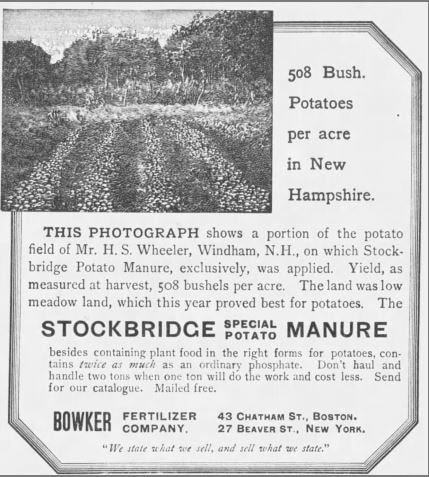|
In 1893 the average American potato farmer produced just over 78 bushels of potatoes per acre, according to research compiled by the Federal Reserve Bank of St. Louis. That same year, with help from some specially formulated manure, one local farmer was able to crush that average with a yield of 508 bushels per acre. Henry S. Wheeler was a farmer on the Windham/Derry line, on what was known as the "Fitz Farm". Wheeler lived on the farm with his wife, Hannah, a Derry native he married in 1877, along with their five children: Caroline, Sarah, Mary, Elizabeth, and Henrietta. With a family of seven to feed, Wheeler undoubtedly needed any advantage he could find in ensuring a successful harvest each year. In 1893 Wheeler tried Stockbridge Special Potato Manure, which resulted in a fantastic harvest of over 500 bushels of potatoes per acre. According to an ad for the product, it contained "plant food in the right forms for potatoes" in quantities "twice as much as an ordinary phosphate". With double the amount of ingredients as competing manures, Stockbridge was advertised as a time saving and money saving alternative to their competitors: "Don't haul and handle two tons when one ton will do the work and cost less." Such a proposition was undoubtedly attractive to Wheeler who was so successful with the product that the company took a photograph of his farm to use in their advertising.
0 Comments
Leave a Reply. |
AuthorDerek Saffie is an avid Windham historian who enjoys researching and sharing his collection with all those interested in the history of the New England town. Archives
November 2019
Categories
All
|
